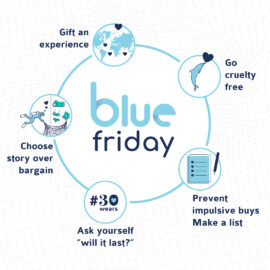Instead of Black Friday, Healthy Seas came up with the great concept of Blue Friday. But what is it? And why do we even need such a concept?
Black Friday is now known across the world as a day of sales in retail shops and online. Sometimes, it extends into the weekend, and into Cyber Monday. People are out for a bargain whether they need it or not. The lowered price tags and clever marketing have created a craze. It’s the “shop till you drop” culture anchored in consumerism. This infamous video illustrates the point but there are hundreds like it online, including some of people physically fighting over discounted items. And now we already start to understand the appeal of a “Blue Friday” encouraging you to shop more consciously. But, in case you first need more convincing, here are a few more facts.
When did it start?
Black Friday is intrinsically linked to today’s culture of overconsumption. But it started as a negative term coined by police and taxi drivers to describe the congested traffic caused by Christmas shoppers around Thanksgiving in the 1960s. In the 80’s, U.S. marketers claimed the term to refer to their sales. Since 2013, the UK adopted the concept, which we nowadays know globally.
What are the negative effects of Black Friday?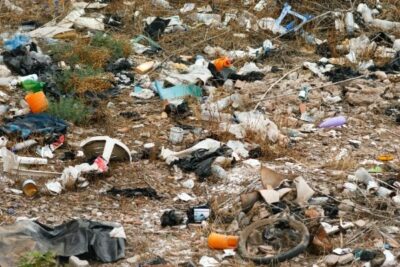
- It encourages overconsumption. The drastically slashed prices are tempting enough on their own. But, by making them a “limited time only”, Black Friday adds the threat that they’ll only be around for a short while, encouraging a false sense of urgency and impulse purchases.
- It changes our perception of value. Black Friday shares the guilt of this with other sales and fast fashion in general. Consumers now prefer to wait until prices drop before they purchase. Low prices have become more desirable in our minds over real product value and product quality. This is especially problematic considering that such low prices for goods are often only possible because of cheap labour, and poor environmental practices.
- Black Friday generates a huge amount of waste. As shoppers buy more than they need, or maybe gift thoughtlessly, too much of the haul will eventually be trashed, contributing to a waste accumulation. Even what is donated may end up in a landfill in Ghana or the Chilean desert for example.
- It contributes to excess CO2 emissions, which harms our planet. Producing every object or garment has an impact already. The delivery of those items itself increases the amount of CO2 around this “weekend of bargains”.
10 tips to have a Blue Friday
Now you see the problem with Black Friday and how bad it is for the environment. That’s why Healthy Seas challenged me to participate in Blue Friday. So, I’d like to share with you my top 10 tips to shop more ethically and sustainably. Let’s get into it!
1. Bring your own shopping bags
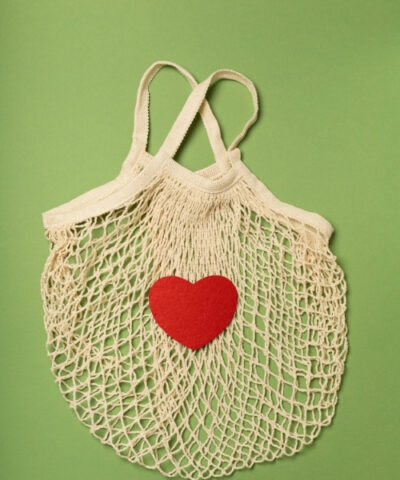 Let’s start easy! If you are physically going into a shop for Blue Friday, bring your own shopping bags. Even if many small stores are more sustainable nowadays, offering paper bags, nothing beats reusing something you own. Always think reusable over disposable. Paper bags come from trees and also have a carbon footprint so avoid them if possible. Of course, this also applies to plastic bags, which I personally consider as a big no.
Let’s start easy! If you are physically going into a shop for Blue Friday, bring your own shopping bags. Even if many small stores are more sustainable nowadays, offering paper bags, nothing beats reusing something you own. Always think reusable over disposable. Paper bags come from trees and also have a carbon footprint so avoid them if possible. Of course, this also applies to plastic bags, which I personally consider as a big no.
2. Ask yourself the right questions & make a list
Who doesn’t like a bargain? I myself often wait for sales to buy something I need. But this is where the focus should be: something you need. Sales are a great way to access things that are normally out of your budget, or even your Christmas gifts. However, you can be easily distracted or seduced by the deals in front of you. That’s how marketing works. So, to make sure that you don’t fall for impulse buys, ask yourself the right questions. Then, make a list and stick to it.
- Do I (or the person I plan to gift this to) really need(s) it? What value will it bring?
- How much use will I/he/she/they get out of it? If it’s a piece of clothing, will I commit to at least 30 wears?
- Would I buy it if it weren’t on sale (aside from potential financial limits)?
- Was it ethically made? Were people paid fairly?
3. Buy from ethical brands
Being ethical means that a brand cares about the planet and the workers that makes their items. While this isn’t exclusive to fashion, garment worker exploitation is an on-going issue that is finally gaining momentum. Human rights should never be negotiable. Low price tags have become the norm in the last few decades but are generally synonym of unfair pay and bad working conditions. Ethical brands will usually be transparent and proudly disclose information on their website. Although not all small ethical brands can afford this certification, it can help to look for the B-corp logo when in doubt.
4. Be cruelty free
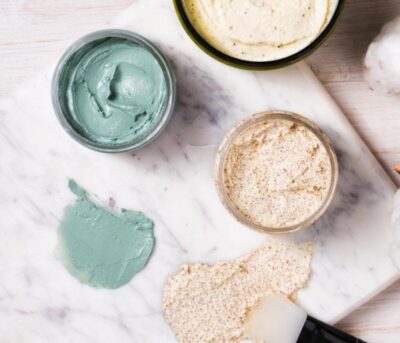 Animal cruelty shouldn’t be negotiable either in today’s day and age. Especially if you’re buying cosmetics, look for the bunny logo in the back of the product. There are three different certifications ranging from Leaping Bunny, to Choose Cruelty Free and PETA’s label. You can also buy vegan products. While this ironically doesn’t guarantee the product is cruelty free, if the ingredients are vegan and natural, it’s usually cruelty free. Again, small brands may be unable to pay for the logo.
Animal cruelty shouldn’t be negotiable either in today’s day and age. Especially if you’re buying cosmetics, look for the bunny logo in the back of the product. There are three different certifications ranging from Leaping Bunny, to Choose Cruelty Free and PETA’s label. You can also buy vegan products. While this ironically doesn’t guarantee the product is cruelty free, if the ingredients are vegan and natural, it’s usually cruelty free. Again, small brands may be unable to pay for the logo.
5. Gift an experience
If you’re using Black Friday to shop for Christmas presents, make it a Blue Friday by gifting an experience instead of something. The options are literally limitless and work for about anyone! A wine lover? Send them to a wine tasting. Your friend is interested in pottery? Subscribe them to a workshop. Someone who wants to get back in shape? Get them a membership to the gym/swimming pool. An adrenaline junkie? Push them out of an airplane (well, not literally). Tickets to concerts, the theatre, or the cinema are all great gifts.
And if, like me, you know someone who has everything and no specific interest that they haven’t satisfied themselves already, this still works! Think haircut, spa treatment, voucher at that boutique they like, etc. They will eventually need these and it even supports small local businesses, which brings me to the next point…
6. Support small and local businesses
The trend of shopping local and support small businesses gained traction during the pandemic as we saw local entrepreneurs struggling. We already all do this to some extent, whether it is your hairdresser or a local pub. So why not take it a step further and seek to purchase more from stores near you? Explore your neighbourhood or take it online! It may not be local but it’s still a win if you’re supporting a small business.
7. Choose story over bargain
 Whenever I get compliments on my swimsuit, I love to tell people it’s made from recycled fishing nets and other nylon waste (ECONYL®, a founding partner of Healthy Seas). That feeling of pride when you know you’ve done right by the environment is unbeatable. So, whether it is for you, or you are buying a gift, pick something of which you will be proud of telling the story. Healthy Seas has partnered with many such brands that you can check out here. This way, you can also boast about how your item tells an incredible story and supports a circular economy and education.
Whenever I get compliments on my swimsuit, I love to tell people it’s made from recycled fishing nets and other nylon waste (ECONYL®, a founding partner of Healthy Seas). That feeling of pride when you know you’ve done right by the environment is unbeatable. So, whether it is for you, or you are buying a gift, pick something of which you will be proud of telling the story. Healthy Seas has partnered with many such brands that you can check out here. This way, you can also boast about how your item tells an incredible story and supports a circular economy and education.
8. Purchase eco items
Whether you are buying for yourself or someone else, “green your life”. A low waste lifestyle can mostly be achieved by changing habits and using what you have first. But you’ll eventually need a few things. If you’re a sweet tooth, you might want reusable silicone cupcake moulds. If you’re buying regenerated waste clothing (as above), you’ll eventually want a microwaste filter to avoid shedding synthetic microfibers when you launder your clothes. Think about the next green step you want to undertake and what can assist you in getting there.
9. Make a donation
In the spirit of sustainability, buying nothing is even better. So if you can’t think of anything a loved one needs this Holiday season, here’s an idea: make a donation in their name. I personally have that loved one who has everything already. 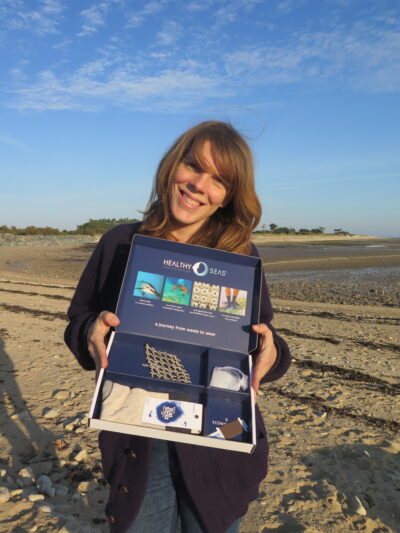 So every birthday and Christmas, I turn to donations. You can plant a tree, pay for the monthly/yearly care of a rescue animal, sponsor a kid’s education, or donate for Ocean conservation via Healthy Seas, or other worthy organisations.
So every birthday and Christmas, I turn to donations. You can plant a tree, pay for the monthly/yearly care of a rescue animal, sponsor a kid’s education, or donate for Ocean conservation via Healthy Seas, or other worthy organisations.
10. Try second hand
Last, but not least! Second hand shops and market places are gaining in popularity, and for good reason. When you are buying something, it’s always more sustainable to get something that already exists versus something that requires more resources and labour to manufacture. In a world full of greenwashing, second hand is always a good bet. It’s also cheaper! Therefore, you may not even need wait for a sale, although some websites will offer special sales and discounts!
Happy shopping this Blue Friday! Remember to purchase mindfully.
Article written by Laura who is an Ocean and sustainability advocate. She related to the concept of Blue Friday and is a long-time Healthy Seas fan. If you liked this read, you can find more of Laura’s work via her Instagram and her website where she shares her tips and journey to sustainable living.
Follow Laura





